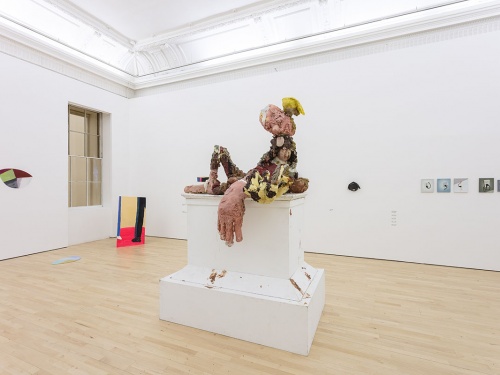Photoshopism
An interpretation of Bloomberg New Contemporaries 2016
As part of our Young ICA programme, four curating students were asked to lead an Educator's Tour of the exhibition Bloomberg New Contemporaries 2016 and write about the artworks that fell within their chosen theme of 'Photoshopism'.
We are four students on our first year of the M.F.A Curating course at Goldsmiths, University of London and were chosen by our tutor, New Contemporaries director Kirsty Ogg, to lead a tour of Bloomberg New Contemporaries 2016 at the ICA. Our tour of the exhibition was framed by the idea of Photoshop as a tool through which to understand and unite the artworks on display: hence 'Photoshopism'.
Alice Ongaro
Many of the artists on show at Bloomberg New Contemporaries were born in the same decade as the Adobe program. They grew up with all the possibilities that Photoshop offers and have been constantly exposed to images and videos produced and modified using the program. Photoshop allows its users to see reality as a stratum of layers that are subject to de-assembling/re-assembling by cut-copy-pasting, masking and filtering; the use of layers, textures and the aesthetic quality is a crucial premise in many of the works in the exhibition.


The image of the cloud, an aggregation of pixels, was both the prologue and an epilogue of this exhibition at the ICA: Kate Fahey’s Cumulative Loss (2015) was the first work we saw when entering the gallery space and Janina Lange’s Shooting Clouds #2 (2014) was the last image left in our memory when we left. A cloud, no longer in the air, brought back into our physical reality, shaped, tangible, real rather than photoshopped. It felt almost like a statement: we’re coming back to Earth.


Natalija Paunic
I saw the most Photoshop-ish component of this show in the wall texts. They were brief and non-narrative, and yet awfully descriptive. The spectator learnt that Margreta Stolen’s Omega, “Purr” (2016) is not mixed-media, but canvas, acrylic, marker, fur, brass bullet belts, UV print, wool yarn, LED lights and sound. Neither a whole nor a collection of random parts, and somehow resembling both: Omega, “Purr” embodies the uncanny. Much like Meret Oppenheim’s fur-coated cup from 1936, it is alluring and uninviting at the same time. Knowing that an omega is the low-rank wolf in a pack, we could hear the purring sound and see the fur, and possibly relate the two. Stolen sure knows how to assemble the assemblage, without the PSD ever collapsing into JPEG. Her work is a coexistence of all layers that, combined with our personal selective attention, can easily be cancelled out. A couple of metres away, and once again with help from the wall text, Leonor Serrano Rivas quite literally translated the Photoshop technique into the real world in How To Make A Rainbow Or Arch Appear In The Sky (2015)... If you can’t see any rainbows, just make them.
Roisin O’Sullivan
I found Jamie Fitzpatrick’s larger than life sculpture The King (2015) particularly striking. Perched or rather draped atop a podium in the middle of the room, a regally repulsive figure assembled from layers and layers of melted coloured wax asserted its presence and commanded attention. The figure is distorted, its hands and feet are vastly out of proportion to the rest of its body and a strange growth emerges from its wigged head. Looking very closely it is possible to see within the layers of wax hair a small dismembered head becoming engulfed into the materiality of The King’s disgusting form; another dismembered head is hooked up to a mechanism that makes it seem to be chattering away on its own.


A play on historical monuments and sculptures, this work unashamedly mocks the authoritarian structures which it references. More than this however, it seems to be a material configuration of power that is unequal, conflicted and opposing – a ‘malleable condition’. Indeed, the sculpture seems to disintegrate, fragments falling off it and dripping down the sides. It is not only an assemblage but also a dis-assemblage. Within the context of ‘photoshopism’ I saw this sculpture as the material manifestation of our political structure, where the layers are unclear, messy and subject to manipulation and adjustment.
Jinho Lim
The viewing of the second floor was accompanied by an overarching chorus of an a capella song by The Beatles, the source of which being Ruth Spencer Jolly’s We Can Work It Out (2014), a two-channel video installation. The videos show a man and a woman singing the song in sync with its lyrics being typed into a Facebook chat window by invisible hands. What initially sounded like recital of an a cappella duo is actually two one-person-karaoke-videos played in a sync. This might be the future of the world with our ability to Photoshop our own realities: the song sounded nice in harmony, but the singers were in fact just going about their own business individually.
Likewise the bigger picture of the world might not matter to us anymore, because everyone owns their own custom-filtered version framed for their own convenience. And as long as the fragmented realities are neatly rendered, all of them can be photoshopped back again to look like one world that we all live in together. The conflicting results of Brexit and the US election in 2016 reminded us of what lies beneath that neatly unified surface layer. The Photoshop-ism, or the world of the Photoshop generation can be as optimistic as the message of the song We Can Work It Out, only to be followed by indifference and disconnection of individuals all contained in their own spheres. ■
This article is posted in: Articles, Exhibitions
Tagged with: Bloomberg New Contemporaries 2016, Curating, Goldsmiths







